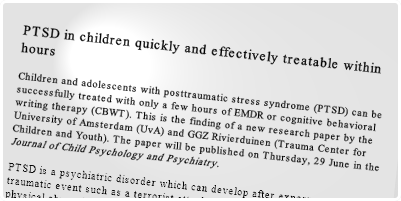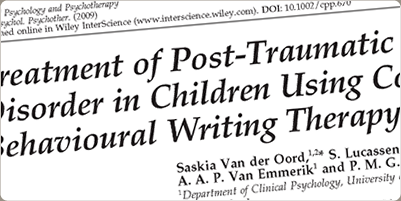WRITEjunior
Cognitive behavioral writing therapy
(The roles of the children are played by actors)
WRITEjunior treatment follows an extensive manual (Lucassen & Van der Oord, 2008) that contains a general treatment outline and special sections for the treatment of trauma after sexual assault or the sudden death of a loved one. In addition, a special section is included on the treatment of children after trauma due to a psychiatric disorder of a parent (e.g. due to borderline personality disorder of a parent witnessing suicide attempts).
The most important elements of the treatment are psycho-education, exposure, cognitive restructuring, promoting adequate coping and social sharing.
The treatment did not include relaxation training or anxiety management techniques. The treatment manual describes age- and child-specific procedures. For younger children the therapist asks if the child is able or wants to type the story themselves on the computer. The older children type the story themselves on the computer. Among children who experienced multiple traumatic events, first, a time line of traumatic events is constructed together with the therapist. Then, together with the therapist, the child identifies the most traumatic event, which is then described in a detailed account. During the course of treatment, the written account of the traumatic event is further integrated into a complete storyline. The story begins with an introduction of the child (e.g. the name and age of the child, the family situation, short history of the life of the child, and why the child seeks treatment), than a detailed description of the traumatic event, in which the child writes down its thoughts, feelings and behavior during and after the traumatic event. Also, the cognitive distortions are written down, and after the cognitive restructuring, the more adaptive thoughts. At the end of the story the child writes how he or she feels now, and how he or she will cope in the future. The story is read by important others/parents without the child being present. After this, the important others/parents, sometimes aided by the therapist, give a written and a verbal reaction to the story.

Journal of Child Psychology and Psychiatry, June 2017
(press release, the article you can find here)

Clinical Psychology and Psychotherapy, December 2009